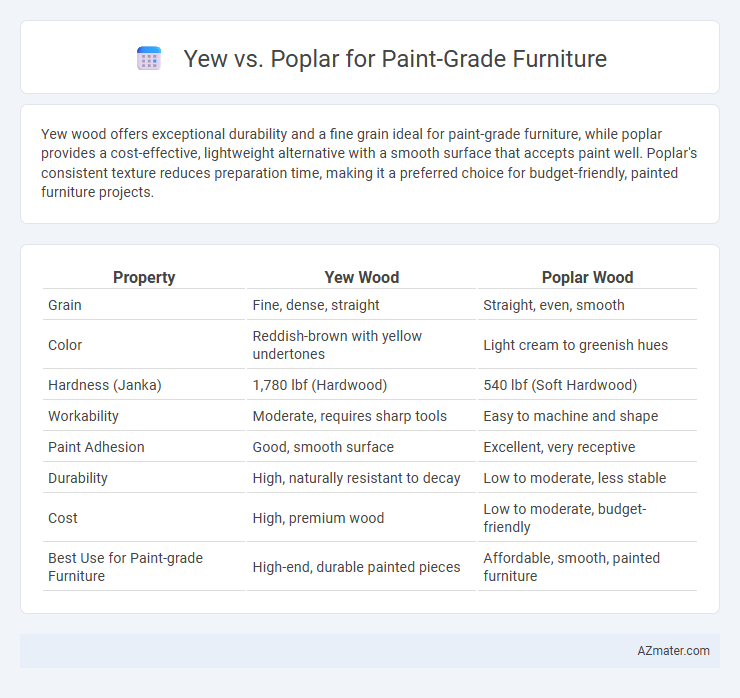Yew wood offers exceptional durability and a fine grain ideal for paint-grade furniture, while poplar provides a cost-effective, lightweight alternative with a smooth surface that accepts paint well. Poplar's consistent texture reduces preparation time, making it a preferred choice for budget-friendly, painted furniture projects.
Table of Comparison
| Property | Yew Wood | Poplar Wood |
|---|---|---|
| Grain | Fine, dense, straight | Straight, even, smooth |
| Color | Reddish-brown with yellow undertones | Light cream to greenish hues |
| Hardness (Janka) | 1,780 lbf (Hardwood) | 540 lbf (Soft Hardwood) |
| Workability | Moderate, requires sharp tools | Easy to machine and shape |
| Paint Adhesion | Good, smooth surface | Excellent, very receptive |
| Durability | High, naturally resistant to decay | Low to moderate, less stable |
| Cost | High, premium wood | Low to moderate, budget-friendly |
| Best Use for Paint-grade Furniture | High-end, durable painted pieces | Affordable, smooth, painted furniture |
Introduction to Yew and Poplar for Paint-Grade Furniture
Yew wood is prized for its fine grain, smooth texture, and natural resistance to decay, making it an excellent choice for paint-grade furniture that requires durability and a flawless finish. Poplar, known for its affordability and ease of workability, offers a consistent grain pattern and takes paint exceptionally well, providing a smooth, uniform surface ideal for painted furniture projects. Both woods are favored in furniture making for their ability to accept paint evenly, but Yew's density and natural oils may offer greater longevity compared to the softer, more porous Poplar.
Wood Characteristics: Yew vs Poplar
Yew wood boasts a fine texture and rich reddish hue, offering excellent durability and natural resistance to decay, making it ideal for premium paint-grade furniture requiring smooth finishes and longevity. Poplar features a softer, lighter-colored wood with a more uniform grain pattern, providing an easy-to-paint surface but less natural hardness and resistance compared to Yew. Both woods accept paint well; however, Yew's density and natural oils create a firmer base for high-quality, durable coatings, while Poplar offers cost-effective versatility for painted furniture projects.
Paint Absorption and Finish Quality
Yew wood offers superior paint absorption due to its tight grain structure, resulting in a smooth, even finish ideal for high-quality painted furniture. Poplar, known for its consistent texture and moderate porosity, absorbs paint well but may require thorough sanding and priming to prevent blotchiness and ensure optimal finish durability. Choosing Yew over Poplar enhances paint adherence and finish longevity, making it preferable for premium paint-grade furniture applications.
Durability and Strength Comparison
Yew wood, known for its exceptional density and tight grain, offers superior durability and strength compared to poplar, making it a preferred choice for paint-grade furniture that requires longevity and resistance to wear. Poplar is softer with a more open grain, which can lead to easier dents and scratches, though it is more economically priced and easier to work with for intricate designs. For furniture that demands long-term structural integrity and a smooth, robust surface under paint, yew provides a more resilient option than poplar.
Workability and Ease of Machining
Yew offers superior workability and ease of machining due to its fine, straight grain and consistent density, making it ideal for paint-grade furniture that requires smooth, uniform surfaces. Poplar is also popular for its softness and minimal grain pattern, which simplifies sanding and finishing processes, though it may dent more easily compared to Yew. Both woods provide excellent results, but Yew's durability and fine texture often give it an edge for projects demanding precision and a flawless paint finish.
Cost and Availability Analysis
Poplar wood is generally more cost-effective and widely available compared to yew, making it a preferred choice for paint-grade furniture manufacturers aiming to balance budget and production efficiency. Yew, while prized for its durability and fine grain for high-end projects, commands a higher price due to limited supply and slower growth rates. Availability of poplar across North America and its faster growth cycle ensures steady inventory levels, whereas yew's scarcity can result in supply chain challenges and increased material costs.
Environmental Impact and Sustainability
Yew wood offers excellent durability and natural resistance to pests, reducing the need for chemical treatments and supporting eco-friendly furniture production. Poplar grows rapidly and is highly renewable, making it a sustainable choice with a lower carbon footprint during harvest and processing. Selecting poplar promotes responsible forest management, while yew's longer lifespan in furniture use contributes to reduced material waste over time.
Best Applications for Yew and Poplar
Yew wood excels in high-end furniture applications requiring tight grain and rich, warm tones, making it ideal for fine detailing and luxury paint-grade finishes. Poplar offers a smooth, even texture and minimal grain pattern, perfect for painted furniture pieces that demand uniformity and cost-efficiency. Both woods perform well under paint, but Yew is preferred for aesthetic appeal in premium projects, while Poplar suits mass production and affordability.
Common Issues and Solutions
Yew wood, prized for its fine grain, often faces issues like resin bleed-through and susceptibility to warping if not properly sealed, requiring thorough surface preparation and multiple primer coats to ensure smooth paint application. Poplar, widely used in paint-grade furniture, tends to absorb paint unevenly due to its porous nature, which can be resolved by applying wood conditioner and using high-quality latex or oil-based primers to prevent blotching. Both woods benefit from sanding between coats and using smooth, durable finishes to enhance paint adhesion and longevity while minimizing common defects like cracking and peeling.
Final Recommendation: Choosing Between Yew and Poplar
Yew offers exceptional durability and a rich, warm grain that enhances paint adhesion and finish quality for paint-grade furniture. Poplar is more affordable and has a smoother surface, making it ideal for achieving a clean, even coat with minimal preparation. For high-end projects demanding longevity and aesthetic appeal, Yew is preferred, while Poplar suits budget-conscious builds requiring efficient painting and consistent results.

Infographic: Yew vs Poplar for Paint-grade Furniture
 azmater.com
azmater.com